Diffuse Ultrasonic Wave-Based Damage Detection of Railway Tracks Using PZT/FBG Hybrid Sensing System
Abstract
:1. Introduction
2. Methodology
2.1. Working Principle of FBG Sensor
2.2. Principle of DUW on Condition Monitoring of Railway Track
2.2.1. DUW Propagation in Railway Track
2.2.2. Energy-Based Damage Index of Diffuse Wave
2.2.3. Waveform-Distortion-Based Damage Index of Diffuse Wave
3. Experiment Procedure
3.1. PZT/FBG Hybrid Ultrasonic Sensing System
3.2. Experiment Setup
4. Experimental Results and Discussion
5. Conclusions
- (1)
- The PZT/FBG hybrid sensing system is adequate for damage detection in railway tracks. The sensitivity of direct wave and DUW is compared in the time domain. Variations of DUW signals are much larger than direct wave signals, which demonstrates the higher sensitivity of DUW than direct wave for damage detection.
- (2)
- The energy-based damage index, EDI, is first defined and utilized to quantify the damage severity at sites 1 and 2. EDI is sufficient to evaluate over-wavelength defects but is not adequate for sub-wavelength defects.
- (3)
- The waveform-distortion-based damage index, PCC, is defined and utilized for damage detection on railway tracks. The results show that the PCC values increase with damage size at all four sites, and the damage index is efficient for damage detection.
Author Contributions
Funding
Conflicts of Interest
References
- Hesse, D.; Cawley, P. Surface Wave Modes in Rails. J. Acoust. Soc. Am. 2006, 120, 733–740. [Google Scholar] [CrossRef]
- Mariani, S.; Nguyen, T.; Phillips, R.R.; Kijanka, P.; Lanza di Scalea, F.; Staszewski, W.J.; Fateh, M.; Carr, G. Noncontact Ultrasonic Guided Wave Inspection of Rails. Struct. Health Monit. 2013, 12, 539–548. [Google Scholar] [CrossRef]
- Rajamäki, J.; Vippola, M.; Nurmikolu, A.; Viitala, T. Limitations of Eddy Current Inspection in Railway Rail Evaluation. Proc. Inst. Mech. Eng. Part F J. Rail Rapid Transit 2018, 232, 121–129. [Google Scholar] [CrossRef]
- Liu, Z.; Li, W.; Xue, F.Q.; Xiafang, J.Y.; Bu, B.; Yi, Z. Electromagnetic Tomography Rail Defect Inspection. IEEE Trans. Magn. 2015, 51, 6201907. [Google Scholar] [CrossRef]
- Wang, S.M.; Liao, C.L.; Ni, Y.Q. A Machine Vision System Based on Driving Recorder for Automatic Inspection of Rail Curvature. IEEE Sens. J. 2021, 21, 11291–11300. [Google Scholar] [CrossRef]
- Liu, S.; Wang, Q.D.; Luo, Y.P. A Review of Applications of Visual Inspection Technology Based on Image Processing in the Railway Industry. Transp. Saf. Environ. 2019, 1, 185–204. [Google Scholar] [CrossRef] [Green Version]
- Mariani, S.; Nguyen, T.; Zhu, X.; Lanza Di Scalea, F. Field Test Performance of Noncontact Ultrasonic Rail Inspection System. J. Transp. Eng. Part A Syst. 2017, 143, 04017007. [Google Scholar] [CrossRef] [Green Version]
- Li, D.; Kuang, K.S.C.; Koh, C.G. Rail Crack Monitoring Based on Tsallis Synchrosqueezed Wavelet Entropy of Acoustic Emission Signals: A Field Study. Struct. Health Monit. 2018, 17, 1410–1424. [Google Scholar] [CrossRef]
- Wang, J.F.; Liu, X.Z.; Ni, Y.Q. A Bayesian Probabilistic Approach for Acoustic Emission-Based Rail Condition Assessment. Comput. Civ. Infrastruct. Eng. 2018, 33, 21–34. [Google Scholar] [CrossRef]
- Chen, S.X.; Zhou, L.; Ni, Y.Q.; Liu, X.Z. An Acoustic-Homologous Transfer Learning Approach for Acoustic Emission–Based Rail Condition Evaluation. Struct. Health Monit. 2020. [Google Scholar] [CrossRef]
- Li, D.; Wang, Y.; Yan, W.J.; Ren, W.X. Acoustic Emission Wave Classification for Rail Crack Monitoring Based on Synchrosqueezed Wavelet Transform and Multi-Branch Convolutional Neural Network. Struct. Health Monit. 2020. [Google Scholar] [CrossRef]
- Hong, M.; Wang, Q.; Su, Z.Q.; Cheng, L. In Situ Health Monitoring for Bogie Systems of CRH380 Train on Beijing-Shanghai High-Speed Railway. Mech. Syst. Signal Process. 2014, 45, 378–395. [Google Scholar] [CrossRef]
- Zhou, C.; Zhang, C.L.; Su, Z.Q.; Yue, X.; Xiang, J.H.; Liu, G.Y. Health Monitoring of Rail Structures Using Guided Waves and Three-Dimensional Diagnostic Imaging. Struct. Control Health Monit. 2017, 24, 1–13. [Google Scholar] [CrossRef]
- Pathak, M.; Alahakoon, S.; Spiryagin, M.; Cole, C. Rail Foot Flaw Detection Based on a Laser Induced Ultrasonic Guided Wave Method. Measurement 2019, 148, 106922. [Google Scholar] [CrossRef]
- Loveday, P.W.; Long, C.S.; Ramatlo, D.A. Ultrasonic Guided Wave Monitoring of an Operational Rail Track. Struct. Health Monit. 2020, 19, 1666–1684. [Google Scholar] [CrossRef]
- Bombarda, D.; Vitetta, G.M.; Ferrante, G. Rail Diagnostics Based on Ultrasonic Guided Waves: An Overview. Appl. Sci. 2021, 11, 1071. [Google Scholar] [CrossRef]
- Cawley, P.; Lowe, M.J.S.; Alleyne, D.N.; Pavlakovic, B.; Wilcox, P. Practical Long Range Guided Wave Testing: Applications to Pipes and Rail. Mater. Eval. 2003, 61, 66–74. [Google Scholar]
- Snieder, R.; Grêt, A.; Douma, H.; Scales, J. Coda Wave Interferometry for Estimating Nonlinear Behavior in Seismic Velocity. Science 2002, 295, 2253–2255. [Google Scholar] [CrossRef] [Green Version]
- Snieder, R. The Theory of Coda Wave Interferometry. Pure Appl. Geophys. 2006, 163, 455–473. [Google Scholar] [CrossRef]
- Zhan, H.Y.; Jiang, H.W.; Jiang, R.N. Three-Dimensional Images Generated from Diffuse Ultrasound Wave: Detections of Multiple Cracks in Concrete Structures. Struct. Health Monit. 2020, 19, 12–25. [Google Scholar] [CrossRef]
- Fröjd, P.; Ulriksen, P. Frequency Selection for Coda Wave Interferometry in Concrete Structures. Ultrasonics 2017, 80, 1–8. [Google Scholar] [CrossRef] [PubMed]
- Chen, B.W.; Abdallah, M.; Campistron, P.; Moulin, E.; Callens, D.; Khelissa, S.O.; Debreyne, P.; Chihib, N.E.; Delaplace, G. Detection of Biofilm Formation by Ultrasonic Coda Wave Interferometry. J. Food Eng. 2021, 290, 110219. [Google Scholar] [CrossRef]
- Lim, H.J.; Lee, H.; Skinner, T.; Chattopadhyay, A.; Hall, A. Fatigue Damage Detection and Growth Monitoring for Composite Structure Using Coda Wave Interferometry. Struct. Control Health Monit. 2021, 28, 1–11. [Google Scholar] [CrossRef]
- Grêt, A.; Snieder, R.; Aster, R.C.; Kyle, P.R. Monitoring Rapid Temporal Change in a Volcano with Coda Wave Interferometry. Geophys. Res. Lett. 2005, 32, 1–4. [Google Scholar] [CrossRef] [Green Version]
- Liu, S.K.; Bundur, Z.B.; Zhu, J.Y.; Ferron, R.D. Evaluation of Self-Healing of Internal Cracks in Biomimetic Mortar Using Coda Wave Interferometry. Cem. Concr. Res. 2016, 83, 70–78. [Google Scholar] [CrossRef]
- Ahn, E.; Shin, M.; Popovics, J.S.; Weaver, R.L. Effectiveness of Diffuse Ultrasound for Evaluation of Micro-Cracking Damage in Concrete. Cem. Concr. Res. 2019, 124, 105862. [Google Scholar] [CrossRef]
- Planès, T.; Larose, E. A Review of Ultrasonic Coda Wave Interferometry in Concrete. Cem. Concr. Res. 2013, 53, 248–255. [Google Scholar] [CrossRef]
- Pomarède, P.; Chehami, L.; Declercq, N.F.; Meraghni, F.; Dong, J.; Locquet, A.; Citrin, D.S. Application of Ultrasonic Coda Wave Interferometry for Micro-Cracks Monitoring in Woven Fabric Composites. J. Nondestruct. Eval. 2019, 38, 1–8. [Google Scholar] [CrossRef] [Green Version]
- Gao, F.; Wang, L.F.; Hua, J.D.; Lin, J.; Mal, A. Application of Lamb Wave and Its Coda Waves to Disbond Detection in an Aeronautical Honeycomb Composite Sandwich. Mech. Syst. Signal Process. 2021, 146, 107063. [Google Scholar] [CrossRef]
- Xie, F.; Zhang, Y.X.; Larose, E.; Duclos, A.; Chen, S.; Li, X.Y.; Fei, C.L. Characterizing Mechanical Change in Metals Using Amplitude-Modulated Diffuse Ultrasound. Struct. Health Monit. 2020, 19, 1894–1904. [Google Scholar] [CrossRef]
- Xie, F.; Li, W.B.; Zhang, Y.X. Monitoring of Environmental Loading Effect on the Steel with Different Plastic Deformation by Diffuse Ultrasound. Struct. Health Monit. 2019, 18, 602–609. [Google Scholar] [CrossRef]
- Pacheco, C.; Snieder, R. Time-Lapse Travel Time Change of Multiply Scattered Acoustic Waves. J. Acoust. Soc. Am. 2005, 118, 1300–1310. [Google Scholar] [CrossRef] [Green Version]
- Lobkis, O.I.; Weaver, R.L. Coda-Wave Interferometry in Finite Solids: Recovery of P-to-S Conversion Rates in an Elastodynamic Billiard. Phys. Rev. Lett. 2003, 90, 4. [Google Scholar] [CrossRef]
- Hu, H.; Li, D.; Wang, L.; Chen, R.; Xu, X. An Improved Ultrasonic Coda Wave Method for Concrete Behavior Monitoring under Various Loading Conditions. Ultrasonics 2021, 116, 106498. [Google Scholar] [CrossRef]
- Michaels, J.E.; Michaels, T.E. Detection of Structural Damage from the Local Temporal Coherence of Diffuse Ultrasonic Signals. IEEE Trans. Ultrason. Ferroelectr. Freq. Control 2005, 52, 1769–1782. [Google Scholar] [CrossRef]
- Fröjd, P.; Ulriksen, P. Detecting Damage Events in Concrete Using Diffuse Ultrasound Structural Health Monitoring during Strong Environmental Variations. Struct. Health Monit. 2018, 17, 410–419. [Google Scholar] [CrossRef] [Green Version]
- Wang, K.; Cao, W.X.; Xu, L.; Yang, X.B.; Su, Z.Q.; Zhang, X.J.; Chen, L.J. Diffuse Ultrasonic Wave-Based Structural Health Monitoring for Railway Turnouts. Ultrasonics 2020, 101, 106031. [Google Scholar] [CrossRef]
- Wang, K.; Cao, W.; Su, Z.; Wang, P.; Zhang, X.; Chen, L.; Guan, R.; Lu, Y. Structural Health Monitoring of High-Speed Railway Tracks Using Diffuse Ultrasonic Wave-Based Condition Contrast: Theory and Validation. Smart Struct. Syst. 2020, 26, 227–239. [Google Scholar] [CrossRef]
- Sun, X.T.; Li, D.; He, W.Y.; Wang, Z.C.; Ren, W.X. Grouting Quality Evaluation in Post-Tensioning Tendon Ducts Using Wavelet Packet Transform and Bayes Classifier. Sensors 2019, 19, 5372. [Google Scholar]
- Hei, C.; Luo, M.Z.; Gong, P.P.; Song, G.B. Quantitative Evaluation of Bolt Connection Using a Single Piezoceramic Transducer and Ultrasonic Coda Wave Energy with the Consideration of the Piezoceramic Aging Effect. Smart Mater. Struct. 2020, 29, 027001. [Google Scholar] [CrossRef]
- Tian, Z.H.; Yu, L.Y.; Sun, X.Y.; Lin, B. Damage Localization with Fiber Bragg Grating Lamb Wave Sensing through Adaptive Phased Array Imaging. Struct. Health Monit. 2019, 18, 334–344. [Google Scholar] [CrossRef]
- Wu, Q.; Wang, R.; Yu, F.M.; Okabe, Y. Application of an Optical Fiber Sensor for Nonlinear Ultrasonic Evaluation of Fatigue Crack. IEEE Sens. J. 2019, 19, 4992–4999. [Google Scholar] [CrossRef]
- Wang, R.; Wu, Q.; Xiong, K.; Ji, J.Y.; Zhang, H.Q.; Zhai, H.Z. Phase-Shifted Fiber Bragg Grating Sensing Network and Its Ultrasonic Sensing Application. IEEE Sens. J. 2019, 19, 9790–9797. [Google Scholar] [CrossRef]
- Yu, F.M.; Saito, O.; Okabe, Y. An Ultrasonic Visualization System Using a Fiber-Optic Bragg Grating Sensor and Its Application to Damage Detection at a Temperature of 1000 °C. Mech. Syst. Signal Process. 2021, 147, 107140. [Google Scholar] [CrossRef]
- Cano, W.F.R.; Rosolem, J.B.; Florida, C.; Lopes, P.H.D.O.; Dini, D.C.; Penze, R.S.; Da Costa, E.F.; Fracarolli, J.P.V. Evaluation of FBG Sensors to Measure Ultrasonic Guided Waves in Rail Transport Monitoring. In Proceedings of the 2017 SBMO/IEEE MTT-S International Microwave and Optoelectronics Conference (IMOC), Aguas de Lindoia, Brazil, 27–30 August 2017; pp. 1–4. [Google Scholar] [CrossRef]
- Wang, J.F.; Yuan, M.D.; Ni, Y.Q. Rail Crack Monitoring Using Fiber Optic Based Ultrasonic Guided Wave Detection Technolohy. In Proceedings of the 11th International Workshop on Structural Health Monitoring 2017, Stanford, CA, USA, 12–14 September 2017; pp. 1763–1770. [Google Scholar]
- Betz, D.C.; Thursby, G.; Culshaw, B.; Staszewski, W.J. Acousto-Ultrasonic Sensing Using Fiber Bragg Gratings. Smart Mater. Struct. 2003, 12, 122–128. [Google Scholar] [CrossRef]
- Wild, G.; Hinckley, S. Acousto-Ultrasonic Optical Fiber Sensors: Overview and State-of-the-Art. IEEE Sens. J. 2008, 8, 1184–1193. [Google Scholar] [CrossRef] [Green Version]
- Lee, J.R.; Tsuda, H.; Toyama, N. Impact Wave and Damage Detections Using a Strain-Free Fiber Bragg Grating Ultrasonic Receiver. NDT E Int. 2007, 40, 85–93. [Google Scholar] [CrossRef]
- Wee, J.; Hackney, D.; Bradford, P.; Peters, K. Bi-Directional Ultrasonic Wave Coupling to FBGs in Continuously Bonded Optical Fiber Sensing. Appl. Opt. 2017, 56, 7262. [Google Scholar] [CrossRef]
- Ray, P.; Srinivasan, B.; Balasubramaniam, K.; Rajagopal, P. Monitoring Pipe Wall Integrity Using Fiber Bragg Grating-Based Sensing of Low-Frequency Guided Ultrasonic Waves. Ultrasonics 2018, 90, 120–124. [Google Scholar] [CrossRef]
- Wu, Q.; Okabe, Y. High-Sensitivity Ultrasonic Phase-Shifted Fiber Bragg Grating Balanced Sensing System. Opt. Express 2012, 20, 28353. [Google Scholar] [CrossRef]
- Su, Z.Q.; Zhou, C.; Hong, M.; Cheng, L.; Wang, Q.; Qing, X.L. Acousto-Ultrasonics-Based Fatigue Damage Characterization: Linear versus Nonlinear Signal Features. Mech. Syst. Signal Process. 2014, 45, 225–239. [Google Scholar] [CrossRef]
- Zhao, J.H.; Durham, N.; Abdel-Hadi, K.; McKenzie, C.A.; Thomson, D.J. Acoustic Guided Wave Techniques for Detecting Corrosion Damage of Electrical Grounding Rods. Measurement 2019, 147, 106858. [Google Scholar] [CrossRef]
- Ge, H.; Chua, D.; Huat, K.; Koh, C.G. Guided Wave–Based Rail Flaw Detection Technologies: State-of-the-Art Review. Struct. Heal. Monit. 2021. [Google Scholar] [CrossRef]
- Tang, Z.F.; Sui, X.D.; Duan, Y.F.; Zhang, P.F.; Yun, C.B. Guided Wave-Based Cable Damage Detection Using Wave Energy Transmission and Reflection. Struct. Control Health Monit. 2021, 28, 1–19. [Google Scholar] [CrossRef]
- Feng, Q.; Cui, J.; Wang, Q.L.; Fan, S.L.; Kong, Q.Z. A Feasibility Study on Real-Time Evaluation of Concrete Surface Crack Repairing Using Embedded Piezoceramic Transducers. Measurement 2018, 122, 591–596. [Google Scholar] [CrossRef]
- Kong, Q.Z.; Robert, R.H.; Silva, P.; Mo, Y.L. Cyclic Crack Monitoring of a Reinforced Concrete Column under Simulated Pseudo-Dynamic Loading Using Piezoceramic-Based Smart Aggregates. Appl. Sci. 2016, 6, 341. [Google Scholar] [CrossRef] [Green Version]
- Lu, Y.H.; Michaels, J.E. A Methodology for Structural Health Monitoring with Diffuse Ultrasonic Waves in the Presence of Temperature Variations. Ultrasonics 2005, 43, 717–731. [Google Scholar] [CrossRef]
- Fu, H.L.; Sharif-Khodaei, Z.; Aliabadi, M.H.F. An Energy-Efficient Cyber-Physical System for Wireless on-Board Aircraft Structural Health Monitoring. Mech. Syst. Signal Process. 2019, 128, 352–368. [Google Scholar] [CrossRef]
- Azuara, G.; Barrera, E.; Ruiz, M.; Bekas, D. Damage Detection and Characterization in Composites Using a Geometric Modification of the RAPID Algorithm. IEEE Sens. J. 2020, 20, 2084–2093. [Google Scholar] [CrossRef]

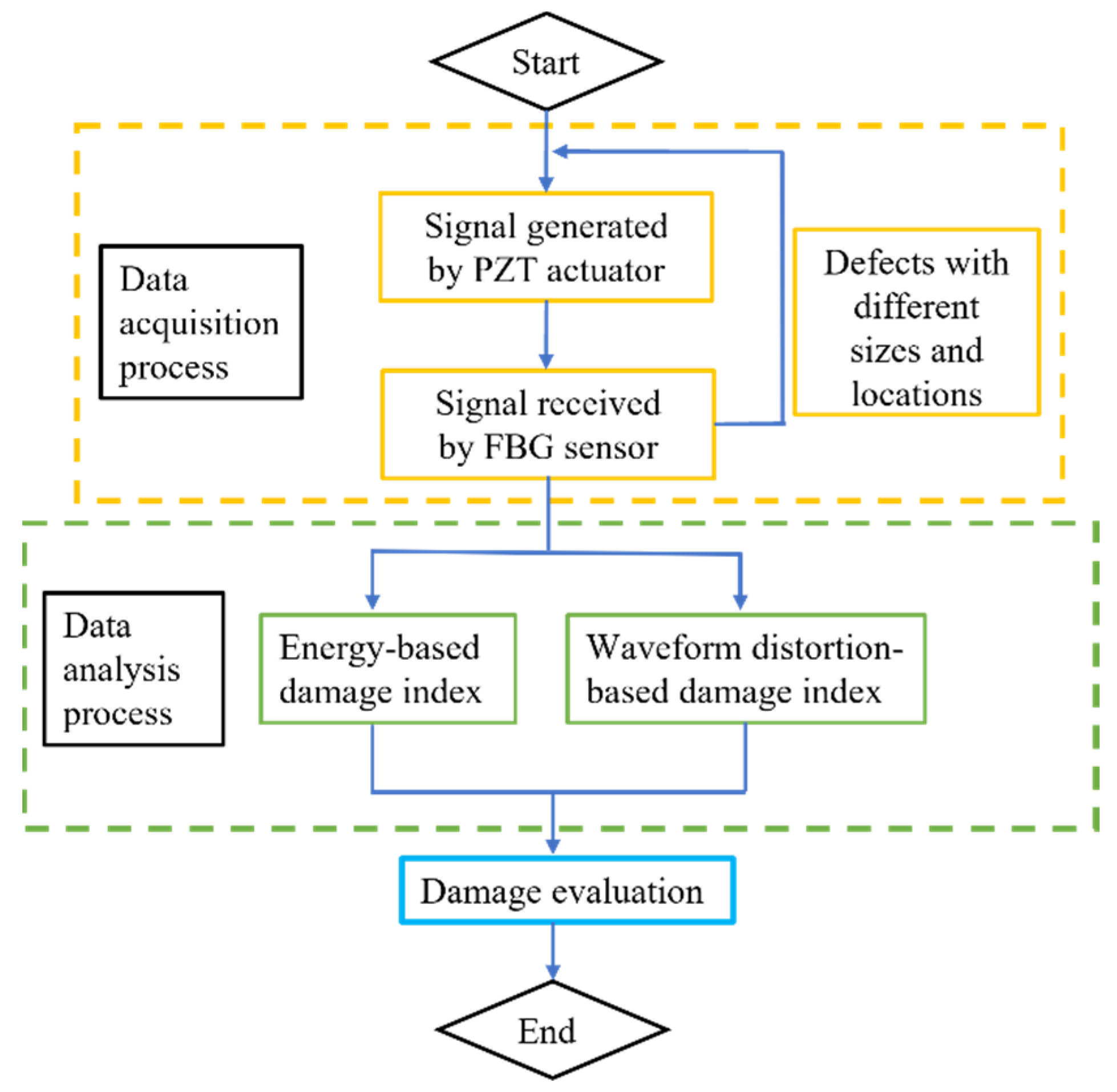
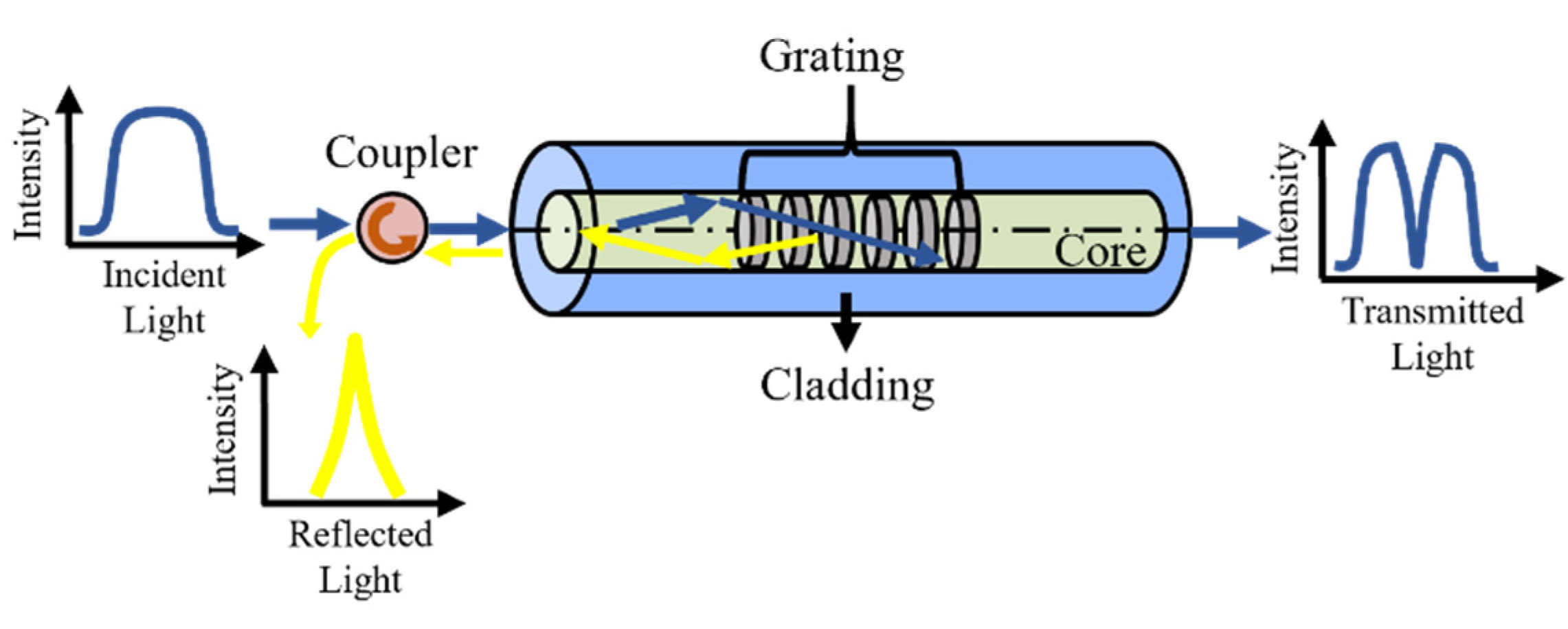

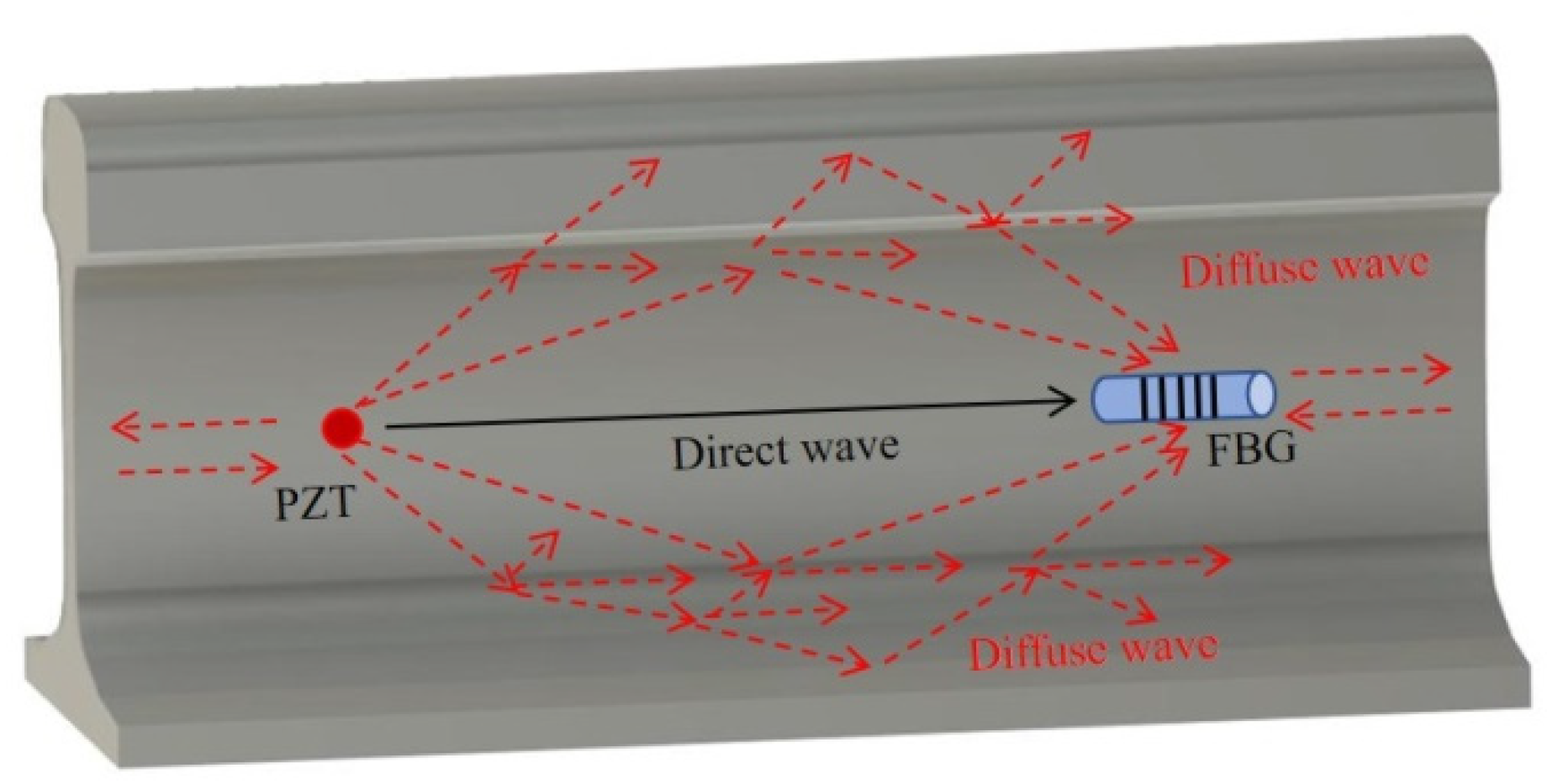
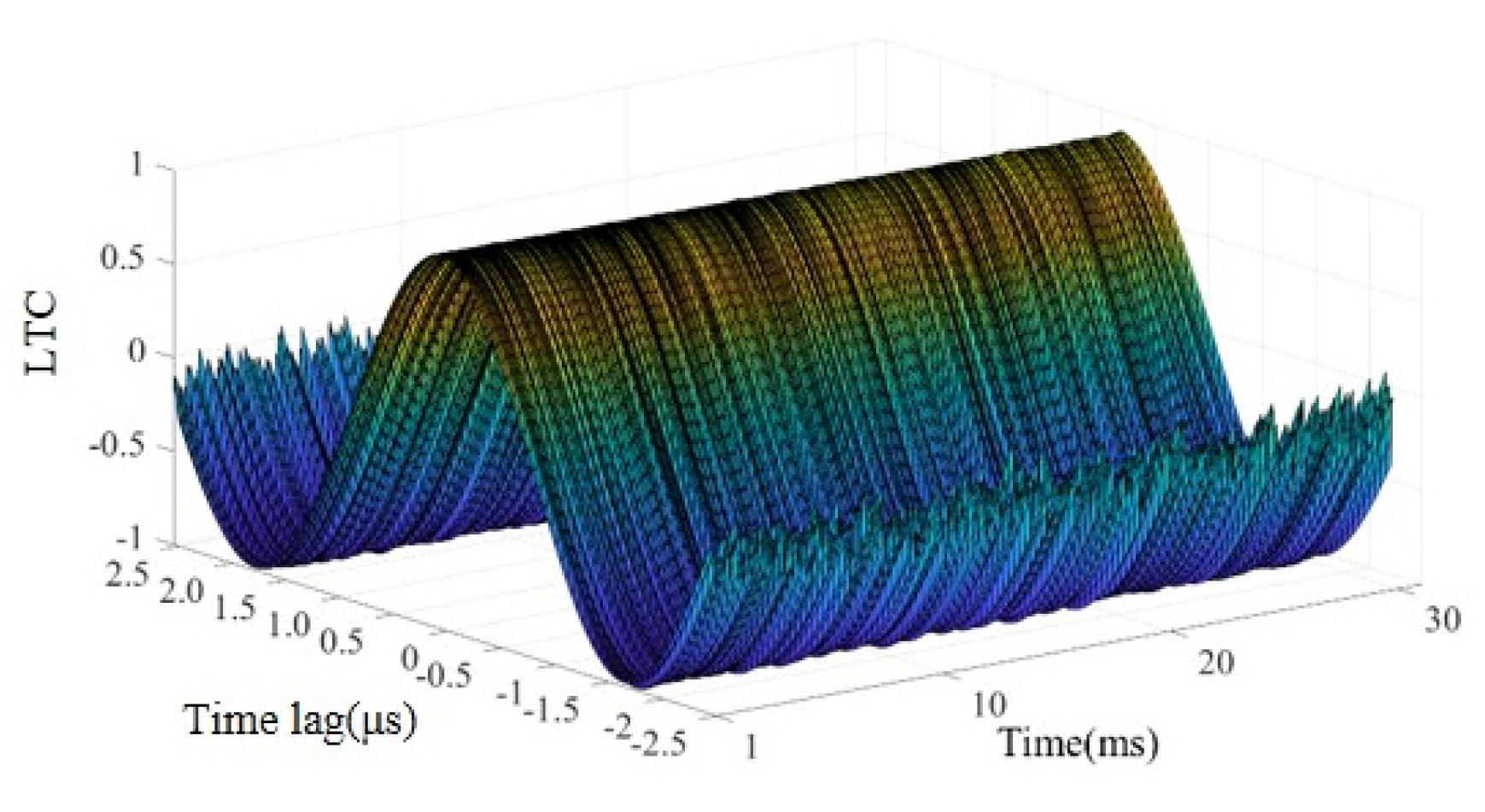

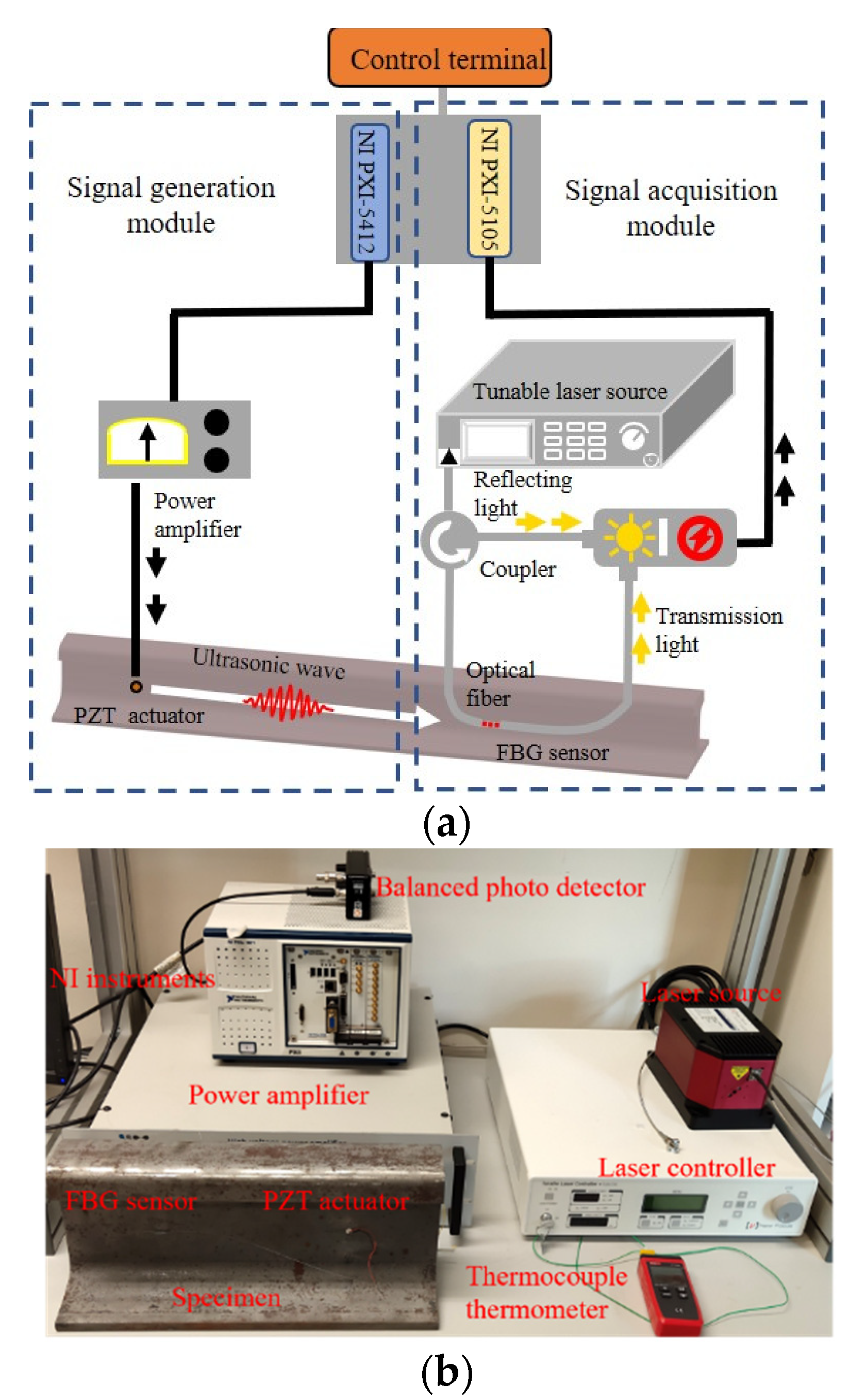
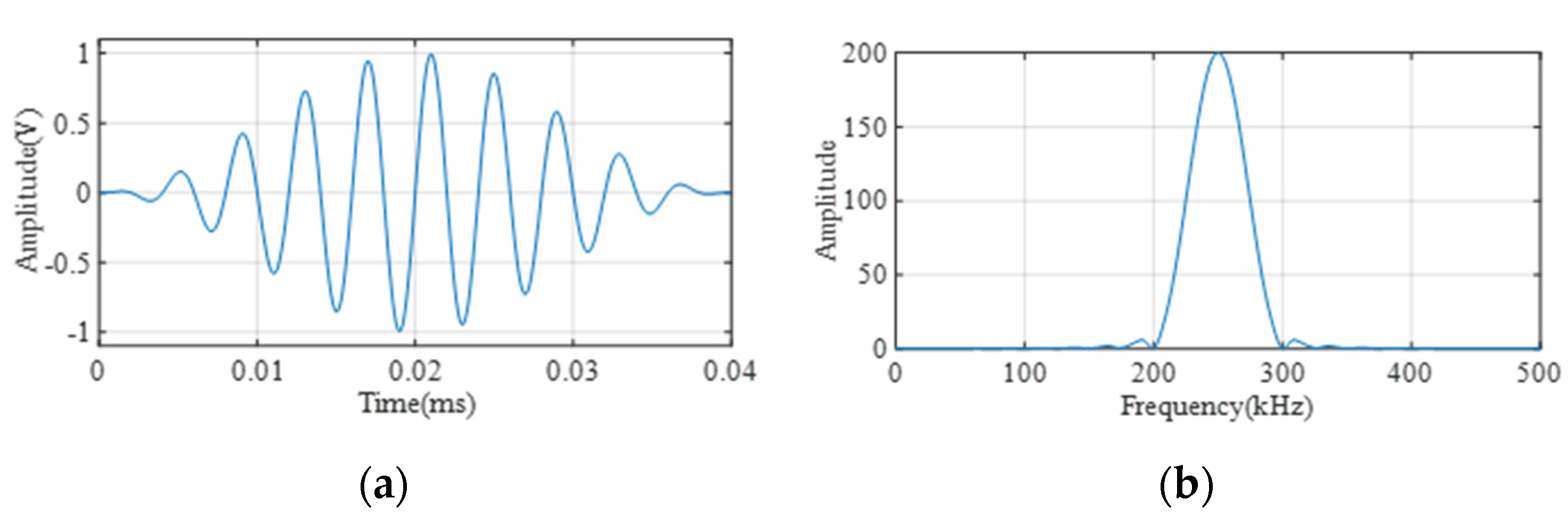
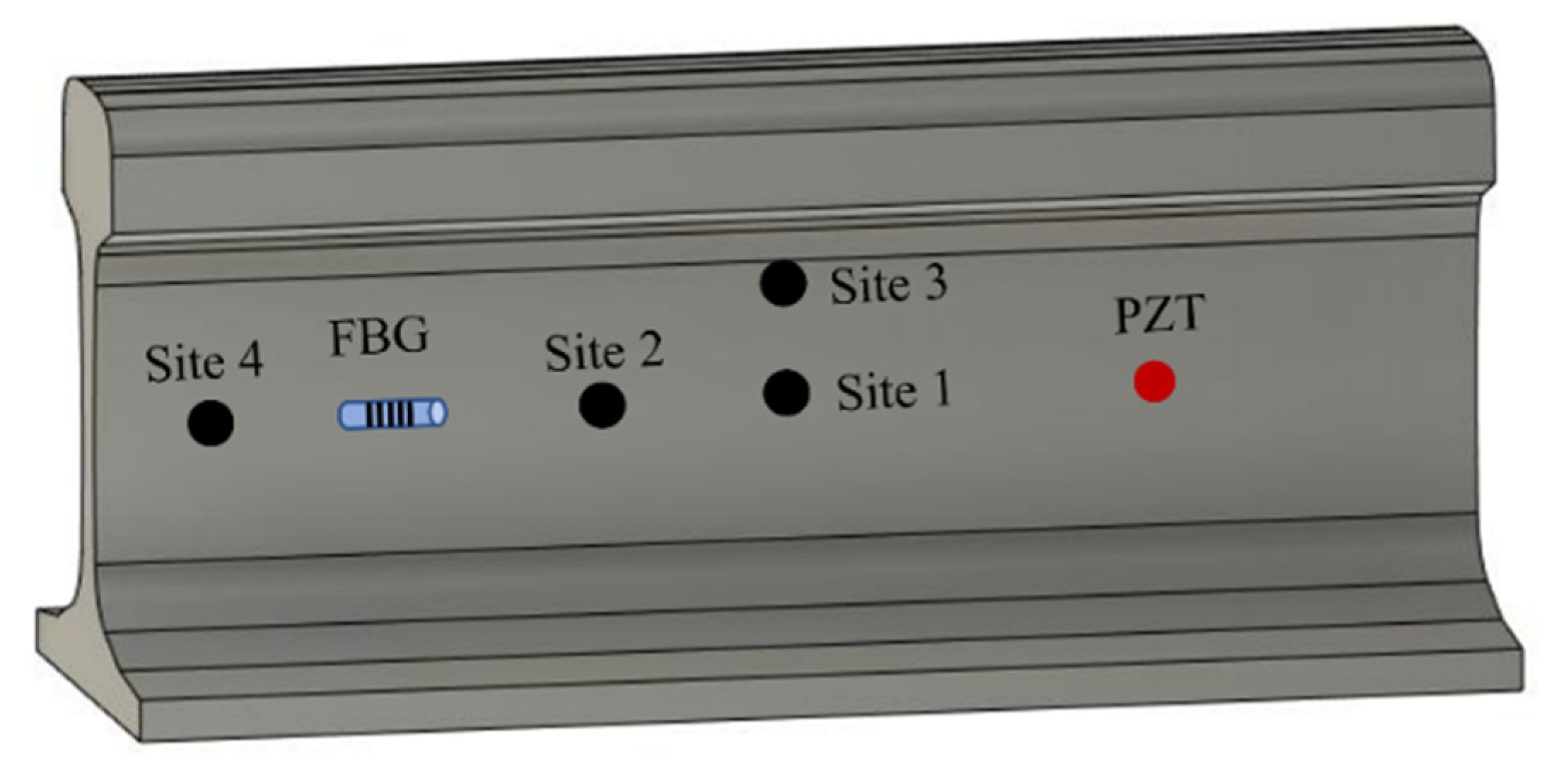
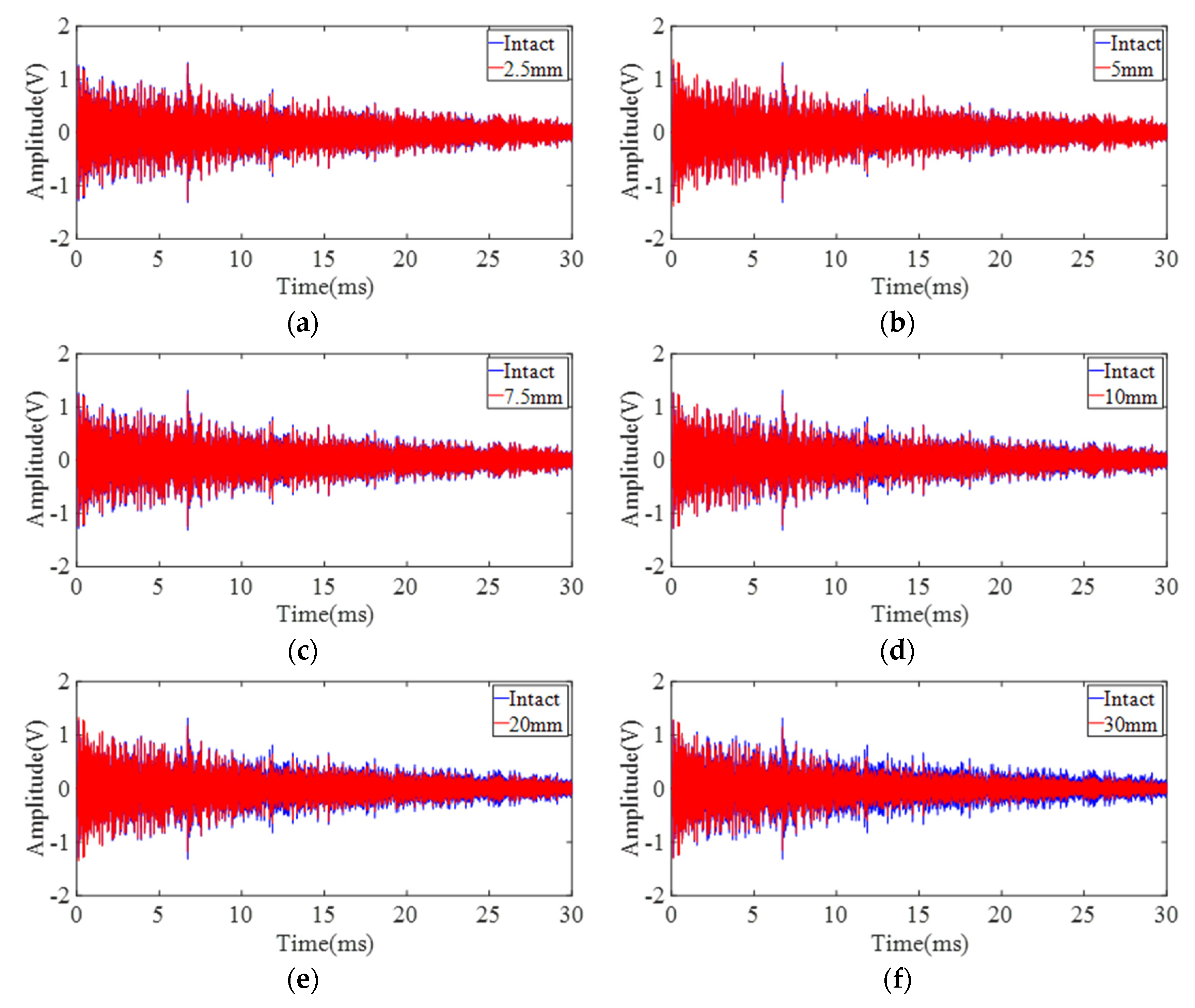



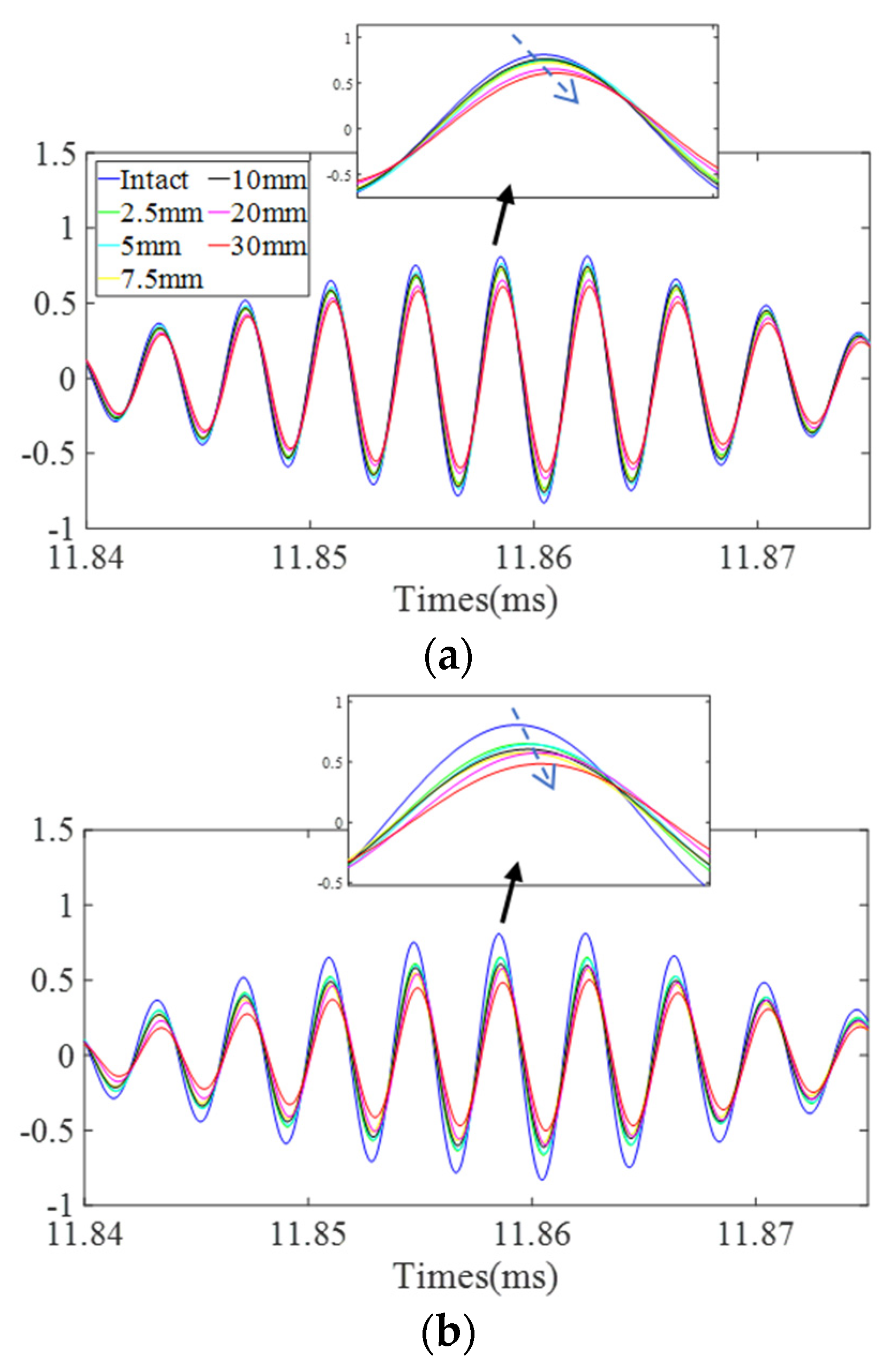

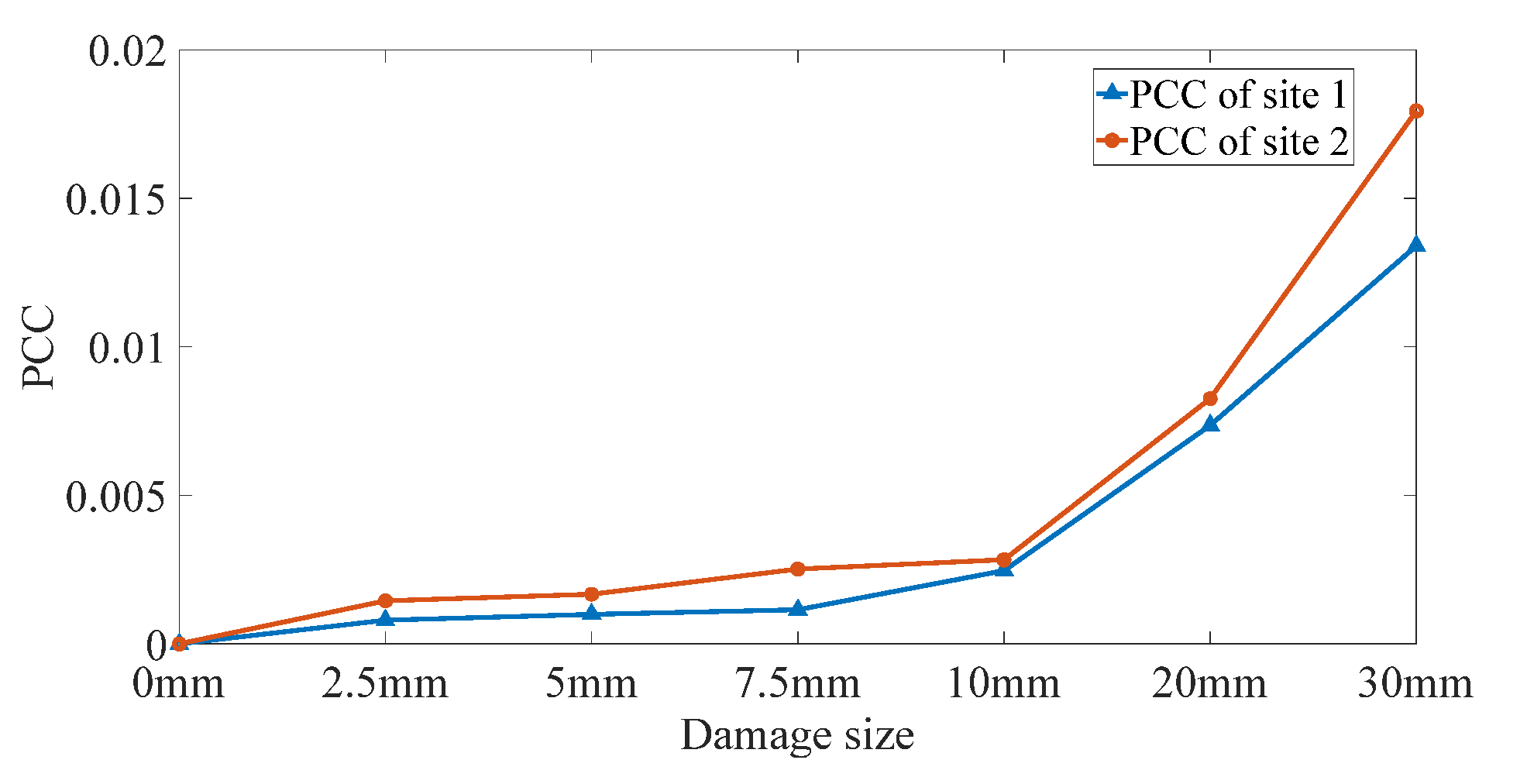
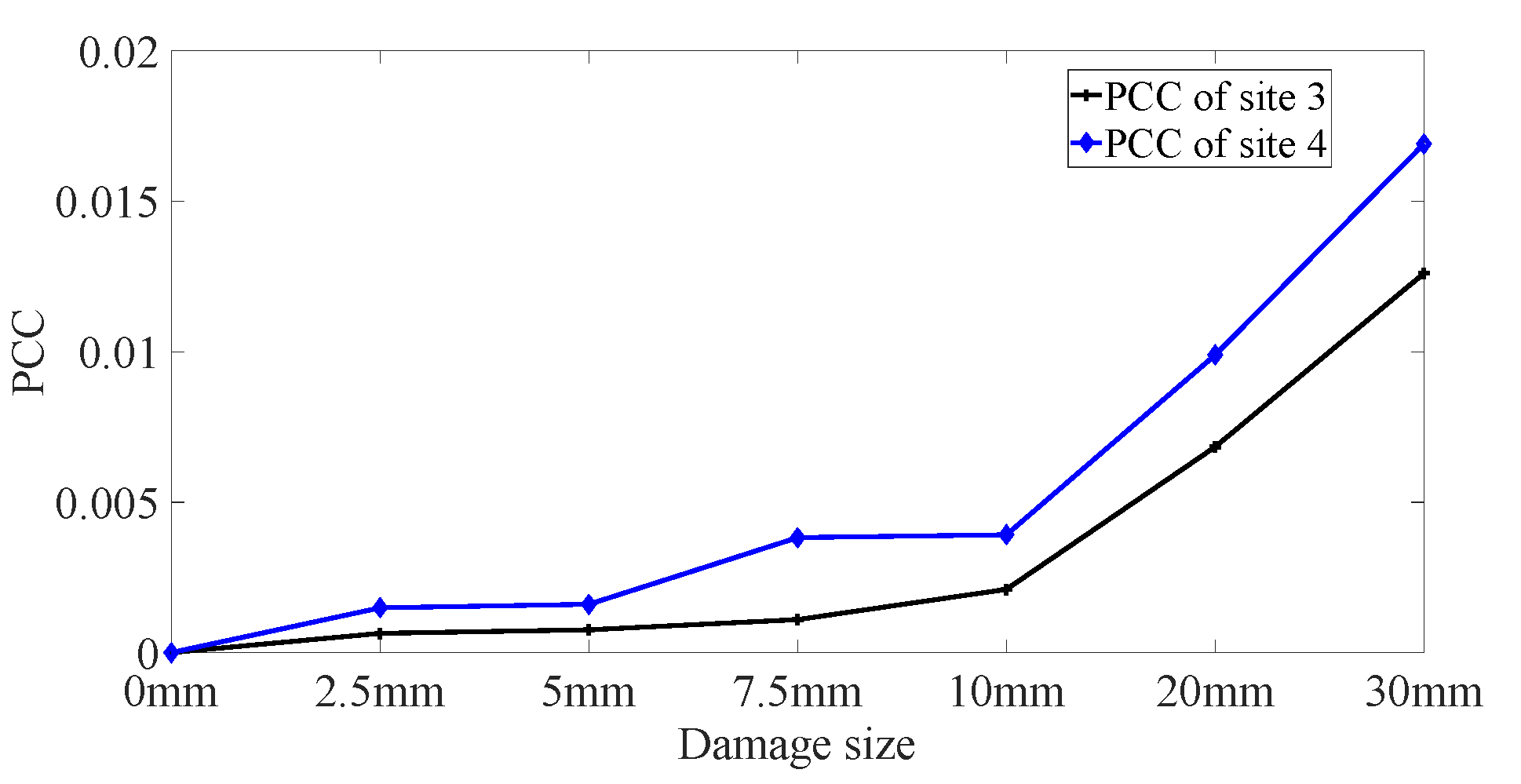
Publisher’s Note: MDPI stays neutral with regard to jurisdictional claims in published maps and institutional affiliations. |
© 2022 by the authors. Licensee MDPI, Basel, Switzerland. This article is an open access article distributed under the terms and conditions of the Creative Commons Attribution (CC BY) license (https://creativecommons.org/licenses/by/4.0/).
Share and Cite
Sun, X.; Guo, C.; Yuan, L.; Kong, Q.; Ni, Y. Diffuse Ultrasonic Wave-Based Damage Detection of Railway Tracks Using PZT/FBG Hybrid Sensing System. Sensors 2022, 22, 2504. https://doi.org/10.3390/s22072504
Sun X, Guo C, Yuan L, Kong Q, Ni Y. Diffuse Ultrasonic Wave-Based Damage Detection of Railway Tracks Using PZT/FBG Hybrid Sensing System. Sensors. 2022; 22(7):2504. https://doi.org/10.3390/s22072504
Chicago/Turabian StyleSun, Xiangtao, Chuanrui Guo, Lei Yuan, Qingzhao Kong, and Yiqing Ni. 2022. "Diffuse Ultrasonic Wave-Based Damage Detection of Railway Tracks Using PZT/FBG Hybrid Sensing System" Sensors 22, no. 7: 2504. https://doi.org/10.3390/s22072504
APA StyleSun, X., Guo, C., Yuan, L., Kong, Q., & Ni, Y. (2022). Diffuse Ultrasonic Wave-Based Damage Detection of Railway Tracks Using PZT/FBG Hybrid Sensing System. Sensors, 22(7), 2504. https://doi.org/10.3390/s22072504






